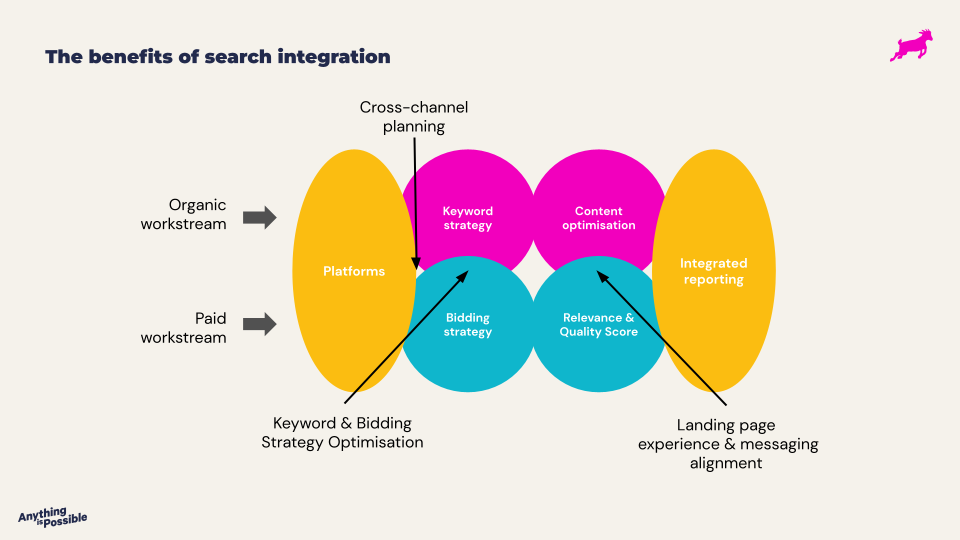Pay Per Click (PPC) search advertising is the bedrock digital advertising strategy. We see it everyday at the top of our Google search pages, with only that little “ad” sign to remind us it’s not a hard-working SEO team who put it there. (See below for more on that!) Getting that coveted top spot and building up your incoming traffic via PPC can seem so costly.
Wouldn’t it be so nice if you could reach those heights without having to pay to be up there?
Good news, it’s possible thanks to SEO.
I also have better news for you (It’s your lucky day)! SEO & PPC are a power couple. Bigger than Benniffer. More unbeliebable than Justin and Hailey.
But how can PPC and SEO work so well together? Let’s find out.
(Before we get started head to PPC & SEO: Differences and Similarities if you need a quick knowledge refreshment!)
Five Ways for PPC and SEO to Work Together
Firstly, let’s try to visualise why SEO and PPC can (and should) work together:

As you can see, there are two main crossovers:
- Keyword strategy & bidding strategy
- Content and website Optimisation & Quality Score
Let’s see below how these crossovers can optimise your Return on Investment (ROI).
-
1. Use PPC search terms to understand user intent
What? Really? I don’t have to spend three hours on keyword research?
Well, I am not suggesting that you don’t do your homework. But I am suggesting that you consider those keywords that we already know are working! Use them as a starting point. We may find very useful hints which we didn’t think about and avoid wasting our time optimising your site for keywords your users are not interested in.
This works especially well with long tail keywords. Simply because when the user is looking for simple information, it is rare that they click on a search ad (unless it is by mistake or the ad is a blog). At that point we can position them at an earlier stage of the conversion funnel (awareness) which, in the long term, is more easily hit through SEO. Mostly, it is rare that advertisers decide to bid on a blog post rather than a conversion-oriented landing page.
-
2. Use Organic Rankings to Pick Your Bidding Keywords
Yes PPC people, SEO can help you on this one. I know it sounds strange, but together we can make the difference for a business’ ROI.
How? Save your investment and re-allocate it.
Each of the organic positions have an average CTR. The lower the position, the lower the CTR (bear in mind that after page 1 it is very rare for users to find you).
Sometimes, the average organic CTR is higher, or equal to the PPC CTR. the only difference? Clicks are free when they are organic.
Hence why we suggest that, especially when a keyword ranks within the first three positions, pause the ads targeting these keywords to reallocate investment into keywords which can help organic growth. This is normally done by using low hanging fruits (keywords ranking between position 10 and 20. Basically, page 2. It’s not without its uses after all!)
Note: Brand keywords work differently.
Your brand strategy is very dependent on the type of your brand and the current competitors. Most likely, branded keywords will rank first. But this is not a reason to take it for granted that you shouldn’t bid on brand keywords.
What? That doesn’t make sense.
Well, unfortunately, competitors will try over and over again to steal your visitors (I mean, that’s the point of competition, isn’t it?) Some competitors will do it only by bidding on your brand keywords and remarketing to your audience whilst working towards the perfect quality score. However, others will use even sneakier strategies. Yes, they will bid on your brand keywords and they will ALSO steal part of your share of search. Oh yes – this happens.
This is why it is more important than ever that the SEOs and PPCs put aside their rivalries and work together.
Ask yourselves: what keywords are the competitors trying to steal? What keywords are we not 100% sure that we rank on #1 for? And maybe keep a couple of them.
-
3. Use SEO for your Technical Optimisations
We learnt earlier that SEO is based on three main pillars, one is technical. Technical SEO includes accessibility, security, and speed. All of these elements are important factors for a website as much as for an ad. If the landing page is not accessible or too slow to load your users will bounce out and the quality score will drop as much as the ranking does.
Remember, Google says that 53% of visits are abandoned if a mobile site takes longer than three seconds to load.
Plus, speed & security are ranking factors. And how can your users or search engine bots access your website if your website is broken?
For this reason, both in the case of a custom-built landing page or one on your main website, it is essential to optimise all these elements.
-
4. Work together on UX and Conversion Rate Optimization (CRO)
Google says that 79% of people are more likely to revisit and/or share a mobile site if it is easy to use.
This statistic should be enough to understand how important user experience is for client stickiness, conversions and traffic. Ease of navigation will not only make users find your content faster. It will also make them remember your site and more likely to return.
User experience, however, is not only about the ease of navigation. It’s also about the user journey. And that’s where we can bond things together.
When the PPC ppl optimise for conversion, their main purpose is to get people to convert (obvious, right?) For this reason we try to include CTAs wherever possible to engage users with your content so that they buy/subscribe/download etc.
Something not obvious, however, is the importance which CTAs have for the user experience and the user journey. When SEOs check the page for its ease of navigation, they also check it from an engagement standpoint to make sure users find it interesting, interactive and stick to the page. This is where the two worlds meet.
For example, for both UX and CRO, CTAs above the fold are fundamental to pick up the user’s attention and engage them with the page. As well as catchy phrases to get them to discover more.
There are more similarities than you thought, huh? But wait a second and read point 5.
-
5. Use SEO to optimise your landing page content
This last point couldn’t be more connected to the previous one. Once the CTAs are ready and a couple of catchy sentences are allocated on page – if it was only for the PPC team – a lot of the content would be put aside or forgotten about to make more space for the ‘essentials’.
Collaborating with the SEO team helps to focus on the strategically optimal keywords, optimising on-page content for organic search and maximising engagement metrics – all whilst working towards CRO.
So, is there any case when you need to use only PPC or SEO?
Sometimes… And this is normally dictated by your budget. All websites benefit by paid-for traffic boosts and constant organic traffic.
Best practice would be to constantly optimise and check your website’s SEO. This lowers your costs in the long term as small issues can be found and fixed on time. And it boosts your traffic and conversions through PPC whenever it is needed.
Ultimately, we believe that the two strategies should always work together to guarantee and maximise your ROI and the success of your website and business.
Is it complex? Is it challenging? Of course it is. Anything worth doing always is.
Can we make it easy for you? Absolutely.




